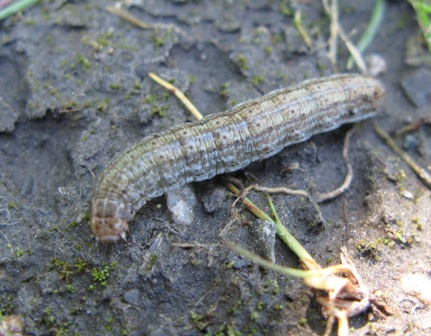Manitoba Insect & Disease Update
Issue 2: May 25, 2016
Summary
Insects: Cutworms and flea beetles on canola are the insects of greatest concern currently. Seed treatments should still be effective against flea beetles in most canola fields, although scouting for feeding damage is encouraged, especially in the earlier seeded fields where seed treatments may soon start losing effectiveness. Cutworm levels are quite variable, hard to find in some fields, more noticeable in others. So scout for potential cutworm feeding on emerging plants and dig for the larvae if you find an area that is showing signs of cutworm feeding.
Plant Pathogens: Scouting for stripe rust in wheat and seedling diseases in emerging crops will be important.
Common Cutworm Questions
Some of the cutworms I have dug up don't seem very active - what could be the reason for this? There are a couple of possible reasons cutworms may not be very active when you find them. One is that there is some disease in the population. Another possibility is that some of the cutworms that were molting (shedding their cuticle to grow to the next stage). They would be very inactive and not feeding during a molt. Research has shown that some species of cutworms can spend about a third of their larval life going through molts, and anywhere from 20 to 50% of larvae can be in non-feeding stage where they are going into or in a molt.
How deep would cutworms be in the soil? How deep cutworms will be in the soil may depend on several factors, including the age of the larvae and how dry the soil is. Younger larvae may stay closer to the soil surface than older larvae. A study with darksided cutworms found that they could be as deep as 8 to 10 cm (3 to 4 inches) in dry soil.
Cutworm Quiz? See if you can guess the name of the cutworms in the 3 photos below (each photo contains 1 species of cutworm).


a) Hint - Note the 2 red stripes down the back b) Hint: note the dark stripes on the side.

c) Note what look to be a series of "V's" of tire tracks on the back.
Answers:
a) Redbacked cutworm
b) Darksided cutworm
c) Dingy cutworm
These are 3 of our more common species in Manitoba. So getting to know these species will be helpful for your crop scouting. Dingy cutworm overwinters as a partly grown larva, while redbacked and darksided cutworms overwinter as eggs. So early in the growing season dingy cutworms may be larger than redbacked or darksided.
Monitoring Tip for Cutworms: As a monitoring tip, sometimes it is easiest to find cutworms by locating feeding damage, using a trowel to shovel some of the soil near the damaged plant into a container big enough that you can then shake the container to level out the soil, and then look through the thin layer of soil for the cutworms. Another option is the use a sieve. These methods generally work well, although wet clay soils can present a challenge for using these techniques.
We need your cutworms! There are a number of research trials going on where cutworms are needed. So if you do find you have some cutworms in your field, why not consider donating some of them to science. Please contact John Gavloski (see contact information at the end of the update) if you do have some cutworms that we can collect. If you are thinking of controlling the cutworms, it would be really good if we can get into the field before it is sprayed and collect cutworms for the trials.
Rust update
Stripe rust has been spotted closer to home. A recent confirmation of stripe rust in two counties in North Dakota makes early scouting even more important.
Root rot
Root rot was found in a fall rye sample submitted to Manitoba Agriculture’s Crop Diagnostic Lab. Root rots and other seedling diseases are of concern in emerging crops. Scouting will be important.
Insect Monitoring Programs
Diamondback Moth: Diamondback moth monitoring with the pheromone baited traps is underway. Some moths have been caught in the traps, but levels so far have mainly been low, with the exception a few higher counts in the Northwest (Swan River and The Pas). The highest count so far is 57 from a trap near Swan River. Table 1 below summarizes the highest cumulative counts in Manitoba.
Table 1. Highest cumulative trap counts for diamondback moth adults over the trapping period May 1 to May 21, 2016.
| Location | Count |
|---|---|
| Swan River | 57 |
| The Pas | 52 |
| The Pas | 32 |
| The Pas | 25 |
| Rosebank | 23 |
A summary of diamondback moth monitoring in Manitoba can also be found at:
A summary of diamondback moth monitoring in Manitoba can also be found at: http://www.gov.mb.ca/agriculture/crops/insects/diamondback-moth-forecast.htmlCompiled by:
John Gavloski, Entomologist Pratisara Bajracharya, Field Crop Pathologist
Manitoba Agriculture Manitoba Agriculture
Phone: (204) 745-5668 Phone: (204) 750-4248
To report observations on insects or plant pathogens that may be of interest or importance to farmers and agronomists in Manitoba, please send messages to the above contacts.
To be placed on an E-mail list so you will be notified immediately when new Manitoba Insect and Disease Updates are posted, please contact John Gavloski at the address or numbers listed above.
